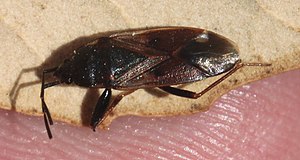Eremocoris fenestratus
| Eremocoris fenestratus | ||||||||||||
|---|---|---|---|---|---|---|---|---|---|---|---|---|

Eremocoris fenestratus |
||||||||||||
| Systematics | ||||||||||||
|
||||||||||||
| Scientific name | ||||||||||||
| Eremocoris fenestratus | ||||||||||||
| ( Herrich-Schäffer , 1839) |
Eremocoris fenestratus is a bug fromthe Rhyparochromidae family .
features
The bugs are 5.9 to 7.8 millimeters long. Like all species of the genus Eremocoris, they have reddish-brown forewings that bear a pair of semicircular white spots on the membrane adjacent to the Cuneus. Like Eremocoris abietis, Eremocoris fenestratus has one large and several small thorns on the thighs ( femora ) of the front legs. The hair on the posterior rails ( tibia ) is not shorter than the width of the rails, but about the same length as they are wide. The top of the body is quite shiny. All adults are macropter, so they have fully developed wings and are able to fly.
distribution and habitat
The Mediterranean species occurs to western and central Europe and in the east to the Caspian region, as well as further to Mongolia. In Germany it occurs mainly in the south and has been found sporadically up to the northern edge of the low mountain range. In Austria it only occurs locally and is rare everywhere. It is mainly in the mountain areas, e.g. B. Widespread in the Alps well above 1000 meters above sea level. The species lives on dry litter of various deciduous and coniferous trees. You can find them on rose plants (Rosaceae) such as B. Roses ( Rosa ) and hawthorns ( Crataegus ) and cypress plants (Cupressaceae) such as juniper ( Juniperus ) and arborvitae ( Thuja ). They can also be found in urban areas.
Way of life
The animals suckle on the seeds of their host plants. The adults are very happy to fly and can be found on various herbaceous plants and woody plants after the winter and also in midsummer. Sometimes they also fly to artificial light sources. New generation adults appear from August. In favorable years, an incomplete second generation can be formed, whose nymphs hibernate.
supporting documents
Individual evidence
- ↑ a b c d Wachmann: Wanzen , Vol. 3, p. 111f
- ↑ Eremocoris fenestratus. British Bugs, accessed December 29, 2013 .
literature
- Ekkehard Wachmann , Albert Melber, Jürgen Deckert: Bugs. Volume 3: Pentatomomorpha I: Aradoidea (bark bugs), Lygaeoidea (ground bugs, etc.), Pyrrhocoroidea (fire bugs) and Coreoidea (edge bugs, etc.). (= The animal world of Germany and the adjacent parts of the sea according to their characteristics and their way of life . 78th part). Goecke & Evers, Keltern 2007, ISBN 978-3-937783-29-1 .
Web links
- Eremocoris fenestratus in Fauna Europaea. Retrieved December 29, 2013
